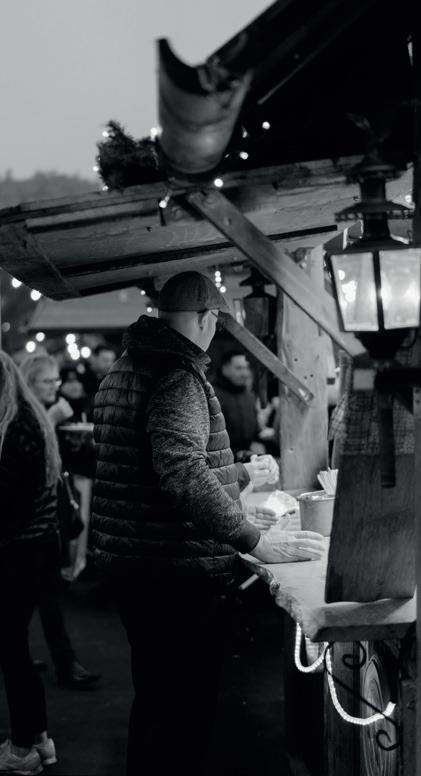
9 minute read
TIME TO CHANGE TACTIC
Get your house in order
The events industry has changed in the last two years, but are you still using the same event marketing techniques? Ed Norris, co-founder and commercial director of Mustard Media, shares his thoughts on the rising trend of outsourced event marketing and why he thinks it’s time to honestly assess your in-house marketing capabilities and rethink your marketing moves
Iwon’t teach you how to suck eggs, but as we all know, the events industry has changed dramatically in the last two years.
One of the changes which I’ve not seen mentioned anywhere, is how event company structures have altered and what possible opportunities this brings.
For anyone overseeing any kind of budget, you will have had to reduce costs to the business wherever possible. In many cases like ourselves, this included letting go of amazing staff to ensure the company survives whilst there are no (or few) events able to go ahead. However horrible, it’s an essential part of survival for both the business and protecting the remaining employees at the company.
ADAPT YOUR CAMPAIGN
Many event marketing departments have scaled back to a skeleton team, and use freelancers or agencies, to fill the gaps when they need to. We go into 2022 with optimism for events this year, however we’re not out of the woods quite yet. Whilst we recover, the shift to freelancers and agencies means you only pay for the work you have on, and tap into expertise you may not be able to hire in.
Alongside your structural changes, comes a complete rethink in how you approach your marketing campaign. The yearly rhythms and usual marketing playbooks you used to use, need to be thrown out. No longer can you rely on the timelines and tactics you once did. There’s a huge number of new considerations never faced before. At any point, a news notification can drop, and ticket sales suddenly stop so reactivity and timing now are fundamental to success. If you get the timing wrong, you can say goodbye to a sell-out event. Gen Z and millennial eyeballs are ever more distracted amongst a world of screens and channels competing for attention. Big launches are now even more important to get your events noticed (and they were already critical to success) alongside scarcity tactics to ensure customers purchase instantly, safeguarding against imminent BBC News notifications driving negative waves of ticket purchasing.
The yoyo-ing of customer confidence is an ongoing challenge too, one which needs to be tackled with live data to inform your next moves within your marketing campaigns. By having access to ticket sales, Google analytics, paid media analytics and marketing campaign data, you can adapt campaigns in the moment, ensure your budget is spent wisely and pick the correct time to drop your big moving pieces of content.
MONITOR DATA POINTS
Slimmed down marketing teams provide much needed relief for companies, but they come with a warning. Often, the newly formed smaller marketing teams are expected to perform not just on par with the full previous team but better. They are supposed to navigate an extremely difficult period with completely new plans and challenges. Work then becomes reactive rather than proactive, and there is no strategy which is being followed, only overflowing jumbled to-do lists and unmanageable expectations. It’s likely you have tasks being done by either too senior or too junior employees or perhaps without the expertise required.
In these instances, you need to provide back up to your team, when they need it most. You need specialists in any areas in which you are lacking the expertise and you need to ensure you are not getting too bogged down with too much on, it’ll only lead to burn out and employees leaving. You need to monitor data points daily, ensure the top-level strategy is strong enough to combat so many changes and have enough resources to implement the key big moments within a strategy sufficiently, along with the daily routines of running marketing campaigns.
What do you need to outsource? You may already be thinking about specific expertise, such as paid media for example, however it’s not always so clear. For example, do you have a strategy which you are confident will take you to where you need to be? Do you have data and experience to back this up?
ELEVATE YOUR MARKETING
The best two ways to think about your marketing team are as fractional executives and internal drivers.
Fractional execs are highly experienced professionals, who have been there, done that and got the lanyard. Unless you are a large organisation, these are a luxury which you will not be able to afford. They are also extremely difficult to recruit and retain and would need a large support team structure. These people may be too expensive to have in your team all year, but you can still get their knowledge when you need it most from freelancers and agencies. If you do not use this level of support yet, the level of expertise it brings, can elevate an event to the next level. Even some of the biggest event companies and organisations use fractional execs to think outside the box, challenge the status quo and combine knowledge to keep your event or festival progressing.
Internal drivers are your amazing internal marketing team. They live and breathe your brand and implement the day-to-day marketing, which does not require the same level of expertise or quantity of work as the fractional executives. Depending on the level of your event will depend on the level and number of this type of person. These are generally mid-level marketeers which have someone in the organisation directing and keeping everything on track.
The fractional executives will…
• Diagnose key challenges, which are holding you back and combat them with actionable solutions • Challenge the norm and create a unique solution encompassing experience, your historical data and up-to-date data and trends • Set your marketing strategy (along yourselves, as no-one will ever know the brand as well as you) • Provide proven techniques and tactics within the strategy • Identify KPIs to tracking to ensure you can measure success for on-going progression • Provide introductions or advice on using external companies, brands, technology, or platforms to gain more data, convert a higher percentage and sell more tickets, faster. • Implement high-level marketing tasks (such as a multi-channel paid media campaign) • Provide data reports which are easily understandable and with suggested improvements.

The internal drivers will…
• Implement your marketing strategy set by the fractional execs on a day-today basis • Liaise with your fractional execs, who are providing implementation, to ensure they have all the assets they require • Run your social media accounts, making sure everyone is responded to in a timely

manner and ensure there is constant nurturing of your audience • Maintain your brands tone of voice through all communication • Create and send email marketing campaigns • Create and build strategic marketing partnerships with media outlets, social media pages and influencers • Brief and manage photo, video, graphic designers, illustrators, and content creators • Liaise with PR/SEO/web specialists to ensure everyone has the correct copy and creative required, and analyse reports, which come from any third parties to ensure they are all doing their job correctly (against the KPI setting). • Liaise with ticket outlets ensuring their marketing efforts are working and any ticket counts or allocations are (smaller teams only, larger organisations will outsource or provide a dedicated team) and being reported on. • Attend marketing workshops, calls and meetings with fractional execs and thirdparty partners.
EVALUATE WHAT YOU NEED
We’re not only seeing a big increase in demand for fractional execs, but also internal drivers. The drivers are much more surprising, as paying agencies are often more expensive than having someone in-house. After all, they are doing timeconsuming work, so it usually involves one or two full time positions for the length of the marketing campaign (depending on the size of your event). This does, however, mean you can hire experienced people with a proven track record and leave them to do all the implementation. You then must jump on weekly calls and look through reports, rather than being in the day to day. Not to mention the added expenses and time of having extra staff members and possible time when they may be employed but with little or no work due to uncertainties.
How does this work then in practice? We often see the following set up as most common:
Your outsourced fractional execs
• Strategy director + supporting strategy team • Head of paid media + supporting implementation paid media team
Your internal drivers
• Marketing director (this sometimes is the promoter, depending on size of event/company) • Marketing and social media manager • Marketing assistant and community manager
More “traditional” outsourced teams
• Press team • Graphic designers • Illustrator/animators • Photographer/videographers
A lot of us have had to change our company set up to navigate the last couple of years. However, this does bring the opportunity to shape it in a more efficient way. Do not just jump right back into hiring a like-for-like replacement for someone who has left. Evaluate what you need, and see if there’s another way in which that role could be fulfilled to a higher level, with the same or less budget. You may have spare capacity with other team members who can pick up certain tasks and outsource the more high-level or specific expertise.

KEY TAKEAWAYS
• The festival and events industry has big changes in marketing company set ups. They are looking more to outsourcing to keep overheads down, only paying external expertise as and when they need it rather than on payroll. • Alongside company structural changes, event and festival marketing campaigns have changed dramatically in approach, meaning a new strategy is required to combat new challenges. • A scaled-back marketing team presents a new set of challenges, the team will be stretched and likely working day to day, with no proper vision and being reactive rather than proactive, not getting the expected results. • You should be looking to boost the team with specific outsourced help, when they need it most, looking at both expertise and internal resources. • When considering, split these up into two categories (both essential to long-term success) fractional executives and internal drivers. • Fractional executives are highly experienced professionals who provide clarity and data around your campaign. No matter how large of an organisation, these people hold their own, challenging the status quo and providing real value and ROI when you need it most. • Internal drivers are your day-to-day implementers and number one fans of the brands. They are living and breathing the opportunity to work in such a creative and exciting industry leaving no stone unturned. • Demand for the fractional executives has increased dramatically over the last 18 months from the lack of resources within marketing teams and companies not being able to rely on previous marketing strategies. • Demand for internal drivers has also increased, due to many internal teams being reduced over tough times with no events being able to be held and some completely going from an events team.









